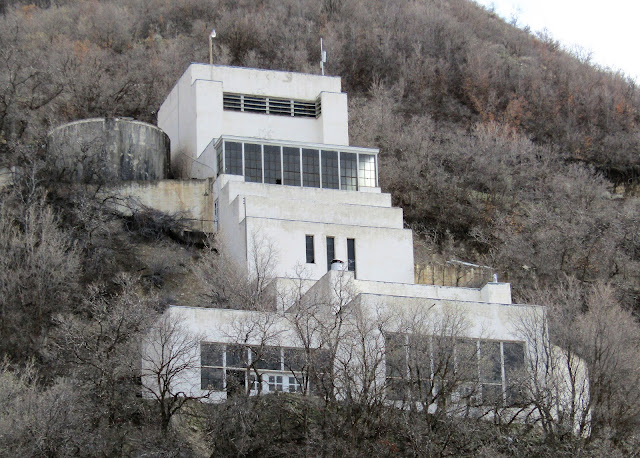by Peter
While driving out to Delta today to dig some trilobite fossils (a topic for another post), I noticed a sign for "Pioneer Charcoal Kilns" accompanied by a couple of beehive-shaped structures on the north side of Highway 132 at the western end of Leamington Canyon. The kilns lie about a mile and a half east of the small town of Leamington in Millard Canyon. We didn't have time to stop on the way there, but made sure to pull into the small gravel parking area on our way home.
 |
| The mostly intact kiln. Note the air control holes visible on the bottom left. |
According to the plaque, four kilns were built in 1882 by Nicholas Paul at the request of George Morrison. The kilns are constructed of squared limestone, with air holes to control the oxygen supply near the base, and roofed with brick domes. Two kilns remain at the site, one with its brick dome and the other open to the sky. The remains of the foundation of a third can also be seen.
 |
| The unroofed kiln. |
The kilns have both an upper door and a lower door. Wood was chopped from pine and juniper in the Gilson and Canyon Mountains to the east, transported down to a wagon road in Leamington Canyon by mule or horse, and then drawn down to the kilns at the mouth of the canyon.
Wood was chopped into four foot lengths. Bundles of wood were brought in through the upper door and stacked vertically around a central fireplace. After the kiln was full, the fireplace was lit with a long torch and the doors stopped up. The small holes at the base could be blocked with stones or opened as needed to keep the fire going at the proper temperature and with the proper amount of oxygen.
 |
| An interior view. You can see the air control holes here, too, although they appear to be blocked. |
Charcoal is produced when biomass is heated in the absence of oxygen and performs best when the heating is slow and at low temperatures. This transforms the biomass (in this case wood), into fuel that produces a high heat and produces little smoke. In this area, charcoal would have been popular with blacksmiths, the railroad (when sufficient coal supplies were not available), and at smelters for area mines. One smelter was constructed a couple of miles away from the charcoal kilns in 1895 and when it closed for lack of ore in 1896, the kilns probably closed as well.
 |
| The brick dome. It looks like it's about one good windstorm from collapsing, but it has held up so far. |
If you happen to be driving down Highway 132, the kilns are well worth a ten minute stop. Be careful, though, the masonry looks to be on the shaky side after 150 years, so use caution when peeking inside.
 |
| The upper door. |
 |
| The upper edge of the wall in the unroofed kiln. |
 |
| The unroofed kiln. |
 |
| The kiln with the complete dome. |
 |
| The upper door in the complete kiln. |
 |
| The unroofed kiln. |












Comments
Post a Comment